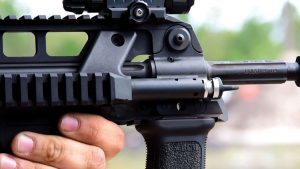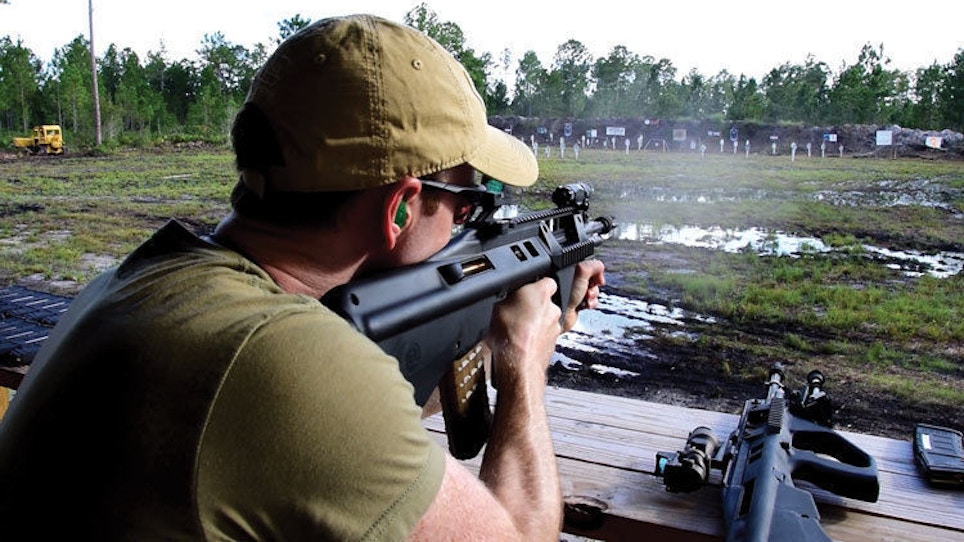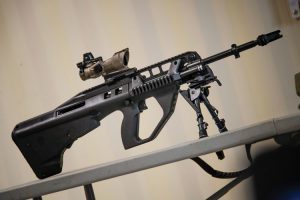If the 2000s were the decade of the AR-15, the 2010s may be the decade of the bullpup; more companies than ever are selling bullpup carbines and accessories to a seemingly insatiable market. Kel-Tec can’t keep its RFB carbines in stock, and IWI is selling nearly every X95 it produces, but one model of the bullpup hasn’t seen the same commercial success as the others — the Steyr AUG.
That is strange because the AUG A3 (Steyr’s most recent version offered for civilian sale) is a solid, reliable firearm with decades of proven capability in the hands of military and counter-terrorism units around the globe. Back in the late ’90s, many believed that was due to the system using proprietary magazines – but that was proven incorrect when Steyr released a version of their AUG that uses STANAG, or standard AR-15/ M16 mags.
The only remaining aspects that could have been holding the system back are its lack of modularity and weight. Well, a new firearms company out of Georgia is looking to fix both issues and many others by importing the latest military version of the AUG currently issued to the Australian military – the F90.
Lithgow Arms USA is that new company and has ties to the original Lithgow Arms of Australia that built all sorts of British military arms throughout World War II. The owner of the new company, Joshua Whi, is no stranger to the firearms import business—he was one of the founders of Lion Heart Industries. For those unfamiliar with that company, it imported Korean military-issue Daewoo pistols based on a modified S&W design.
Enter The Civilian Version Of The F90 — The Atrax
The impetus behind the F90’s development were the very aspects I mentioned above—weight and modularity. As such, the Australian engineering team managed to remove a full pound of excess weight from the original Austrian AUG while moving the gun’s center of gravity to the actual center of the gun.
They accomplished that by partially reducing the amount of excess material from the receiver itself and by fluting the barrel. The latter also has the benefit of permitting the barrel to cool at an accelerated rate by giving it more surface area to dissipate heat.
The superb balance makes mounting a suppressor on the firearm a no-brainer since it no longer makes the rifle so nose-heavy to make it exhausting to shoulder for longer than a few seconds. More in that same vein, the imported guns deviate slightly from their Mil-Spec brethren from down under by incorporating a standard AR-15 1/2x38 thread pitch. That was one of my personal gripes about the original AUG’s 13x1LH pitch as there are almost no muzzle devices that use that pitch.
Because of that, I assumed the gun utilized STANAG magazines, but given the legendary reliability of the original AUG waffle-pattern amber mags, Lithgow decided on a different solution. The company kept the original mags, but contracted Magpul Dynamics to produce affordable polymer magazines for the system. Now shooters weighing the pros and cons of owning the rifle don’t have to worry about magazines—these new Magpul AUG mags are priced the same as their standard Magpul AR-15 mags.
But What About Modularity?

On the right side of the rifle is the adjustable gas system. It was originally meant for launching rifle grenades, but suppressor owners can use it to dial the gun to their desired ammunition.
The original AUG featured a quick-change barrel system that allowed doing so without any tools whatsoever. In fact, shooters could simply press one button and rotate the foregrip to instantly pull the barrel free from the firearm.
The new Atrax takes that a step further, and allows the upper and lower receivers to separate without tools just like on an AR-15. By making the upper barrel group detach so easily, the Atrax makes itself very easy to clean and to swap configurations. So, if a shooter wanted the 24-inch barrel DMR version and the 18-inch barrel standard model, they could readily and easily swap between them.
But that’s not the only way the design is geared toward modularity—the rifle is practically drowning in Picatinny rails. The receiver features a monolithic optics rail that runs just four inches short of the muzzle. Additionally, gone is the integral foregrip, replaced by a short accessory rail that permits mounting of angle foregrips, vertical foregrips, tactical lights and any other Picatinny-mounted accessory.
Also, the Atrax retains the fully adjustable gas system of its AUG progenitor, making it ideal for use with sound suppressors. That also permits the gun to be set to a “high” setting when the rifle is either very dirty or when running under-powered ammunition.
I had a chance to run the Atrax on both semi-automatic and fully-automatic, and in both configurations it was incredibly controllable. That also gave me a new appreciation for the Atrax’s ergonomics, which are superb. The cross-bolt safety of the original AUG is still present, but is now easier and more positive when pressed to either safe or fire. Even on the select-fire model, these are the only settings.
To fire the military version on full-auto, the trigger is simply fully depressed; a half pull being semi-automatic. A trigger-stop is built into the trigger itself and can be engaged with a bullet or tool and disengaged with the press of a button.
The trigger needs mentioning, though. With many bullpup carbines the triggers are atrocious. They feel spongy with lengthy overtravel and never seem to give a crisp break. The Atrax has definitely improved upon that with a much smoother trigger. Still, it’s by no means a match-grade, bolt-action rifle trigger. Thankfully, Geissle automatics will be offering replacement triggers relatively soon.
Overall, the Atrax represents a fully-modernized version of the first military-issue bullpup, the Steyr AUG. Shooters who are on the fence about buying one and wish they could have a Mil-Spec AUG that plays nicely with American aftermarket accessories finally have a reason to smash their piggy banks. It probably won’t attract the sort of customer who only wants an AR-15, but for folks in need of a very compact, yet NFA-compliant firearm in a common, inexpensive caliber, they now give another solid option.







